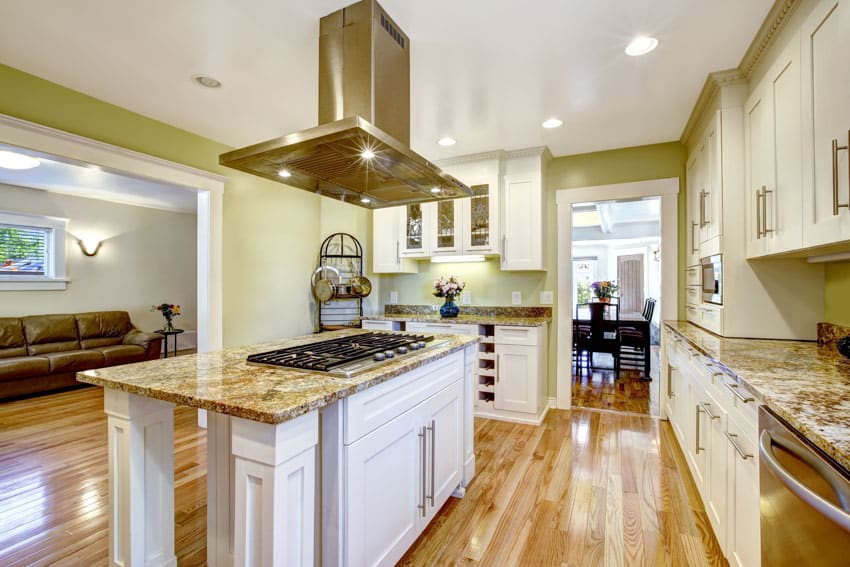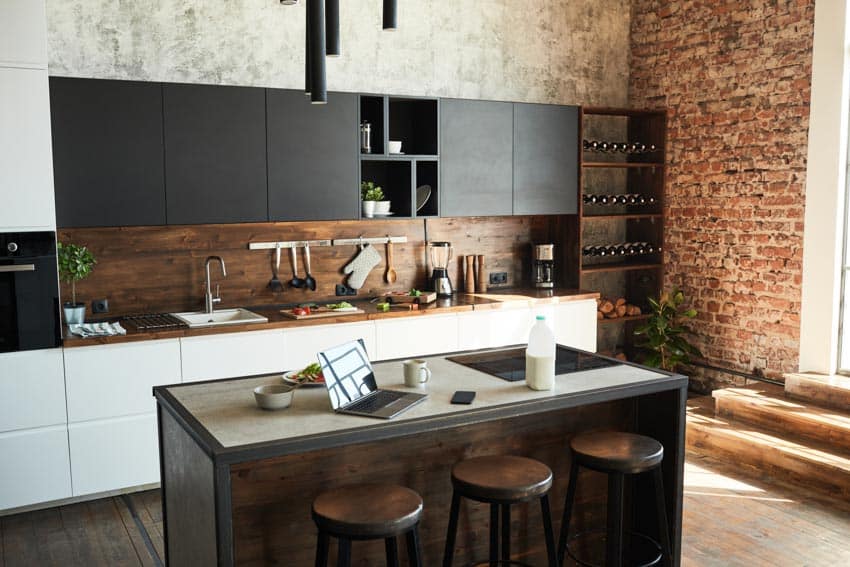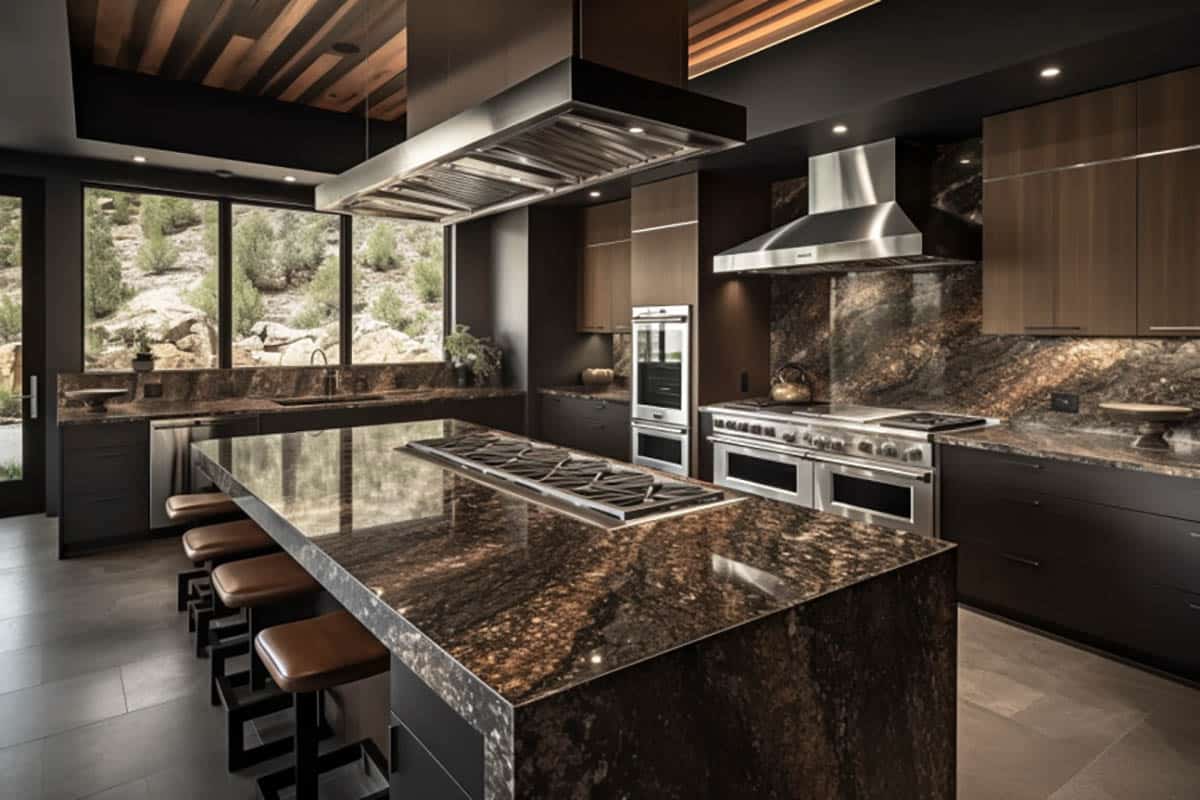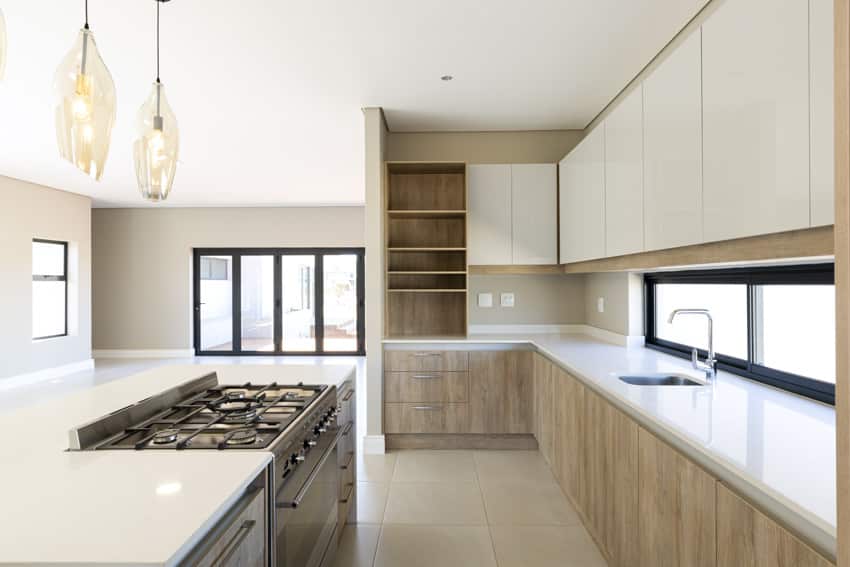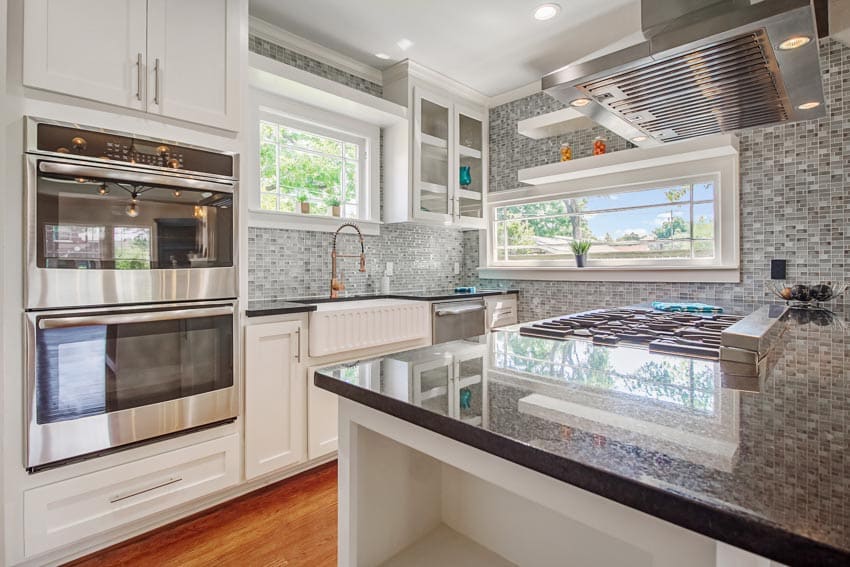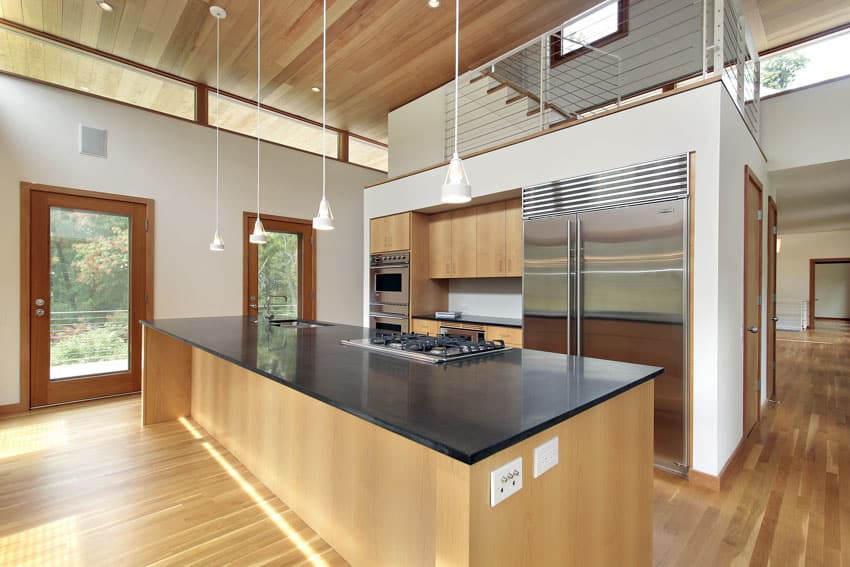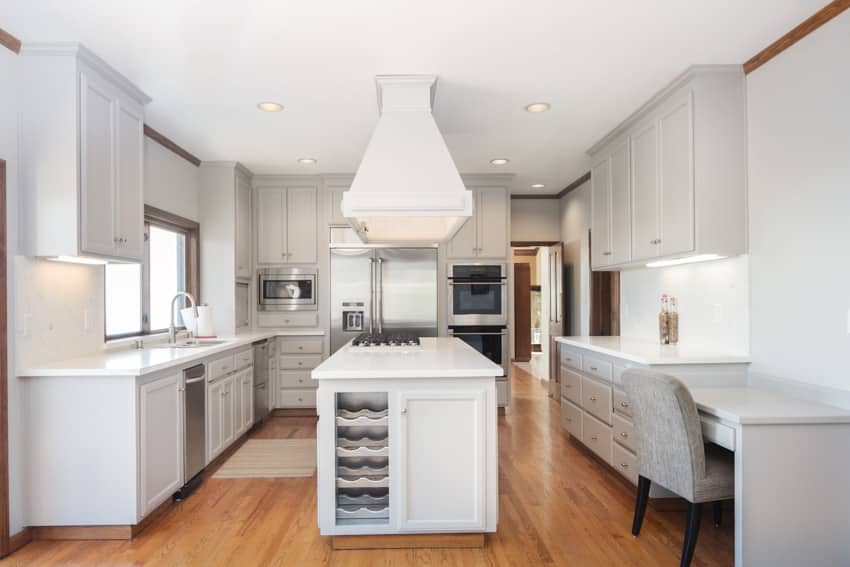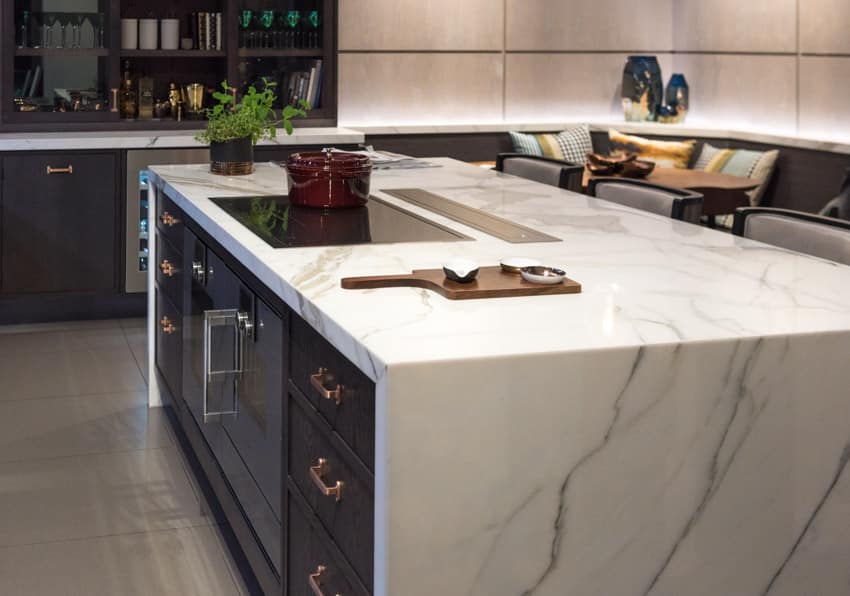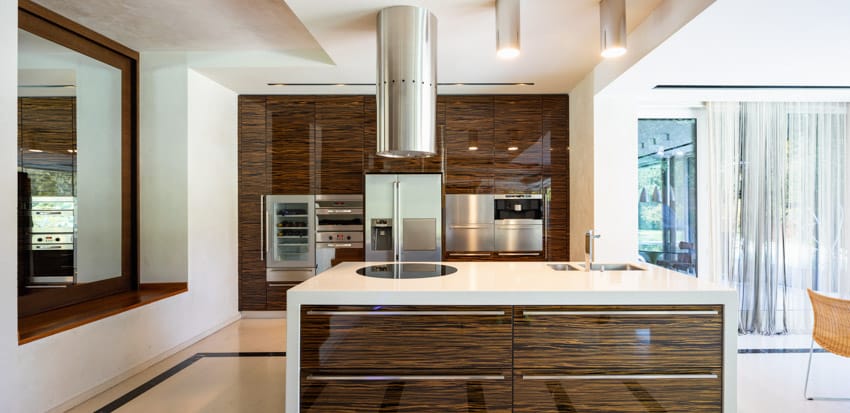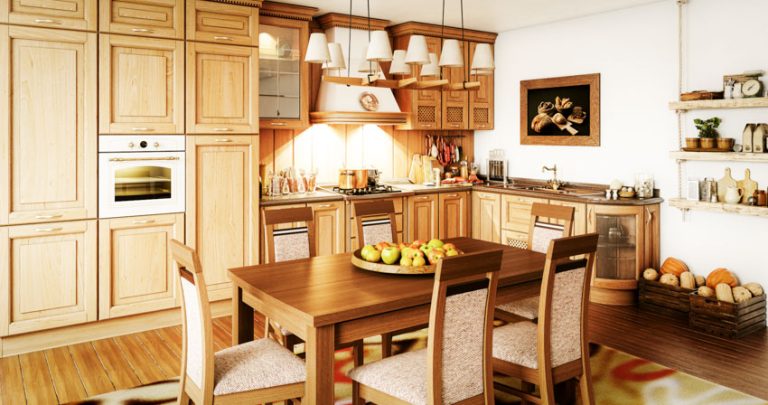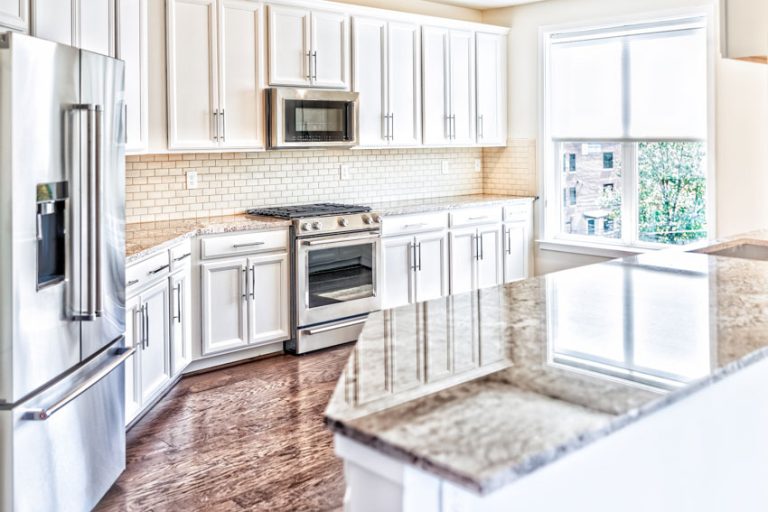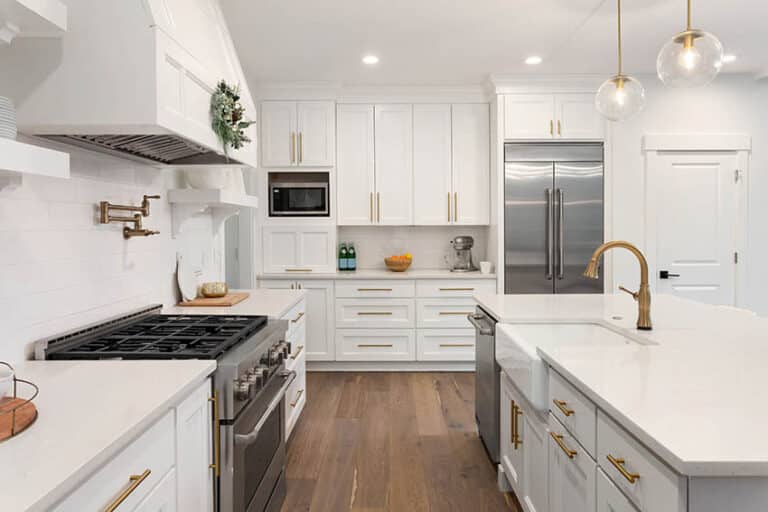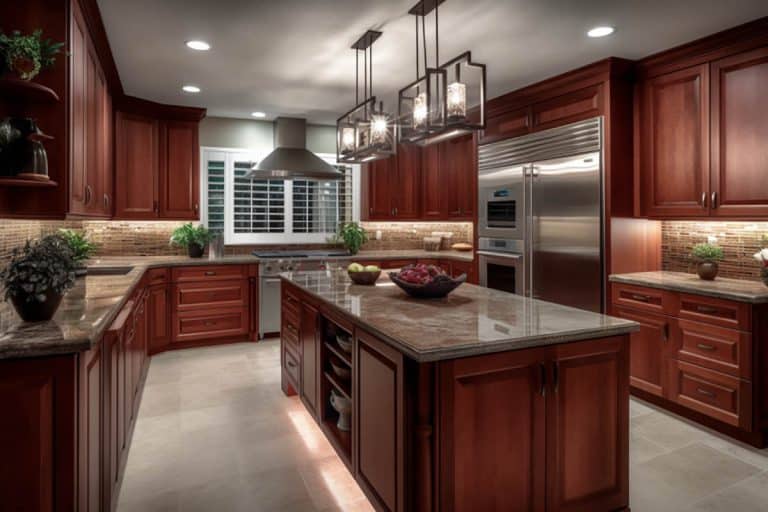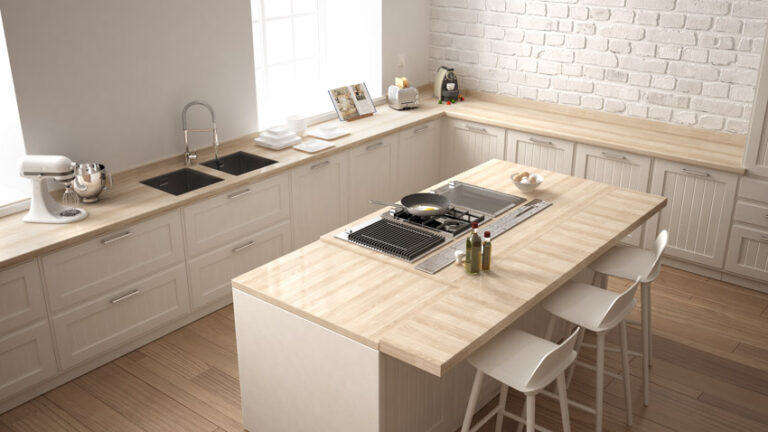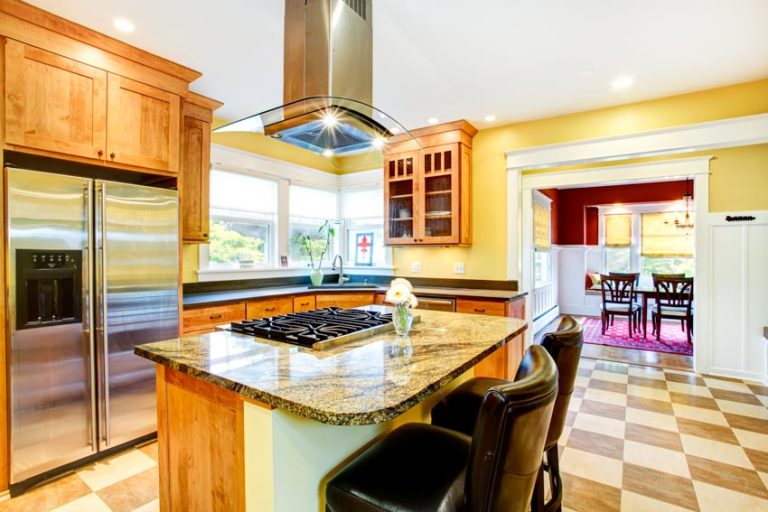Kitchen Island With Stove (Pros and Cons)
See if a kitchen island with stove is a good idea, including its pros and cons, the best type of stove to use, and interior designer suggestions for designs with ovens & stovetops.
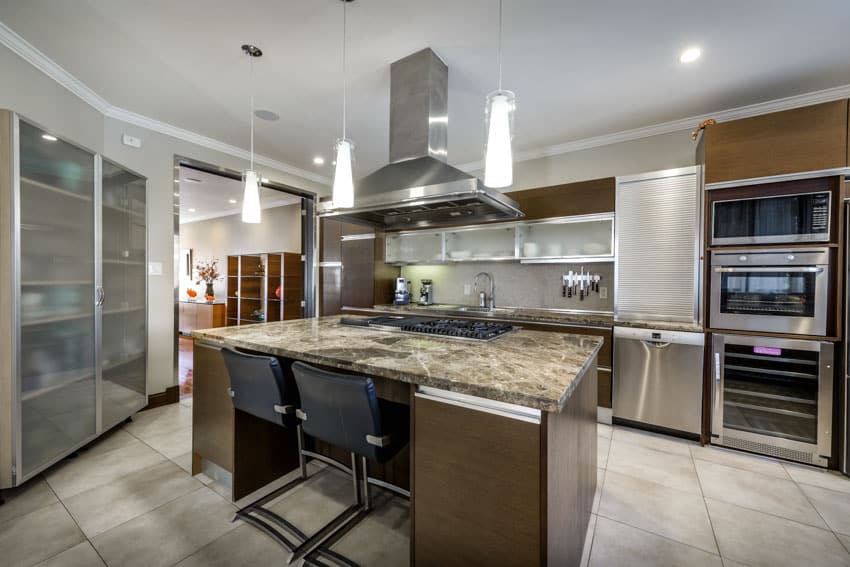
Chefs and food enthusiasts appreciate having a cooking stove on the kitchen island since it provides more cooking and food preparation space. In addition, centralized stoves create a more conversational ambiance, particularly when bar stools are placed around the island.
Nevertheless, you must consider whether you can separate your cooking zone from the periphery. Several cooks regularly exposed to compact, integrated sink counter stoves in a traditional kitchen triangle workspace may be frustrated by this across-the-aisle back and forth.
However, you should consider the pros and cons before placing a stove on your kitchen island. Let us talk about these things in this article.
Although putting a stove on your kitchen island may seem like a crazy concept to others, there are several excellent reasons to do so.
Quick Look – Pros and Cons of a Kitchen Island With Stove
| Pros | Cons |
|---|---|
| Cooking while socializing is achievable | Expensive remodel |
| Extra space for cooking and preparation | Requires a lot of space and extra ventilation |
| Choice between gas or electric stove | Takes countertop space away from food preparation |
| Modern and elegant appearance | Limited material choices |
| Creates a central cooking area that is easily accessible from all sides | Ventilation and any plumbing requirements can be more tricky – always work with an experienced contractor to determine your kitchen’s capabilities |
| Can have dedicated food prep space away from other appliances | Can be more expensive |
| Can incorporate dedicated spice, oils, pots, and pan storage centralized around the stove more easily | May require additional electrical work |
| Cooking can be a lengthy process – bringing a stove to an island keeps you facing family and friends, allowing you to be more integrated as you cook | The stove becomes more easily accessible to those not cooking – a potential safety hazard |
| Islands are traditionally seen as a value-add when it comes to real estate | No backsplash – without a wall behind the stovetop, the oils and sauces from cooking can splatter, coating the surrounding countertop |
| Lighting on the cook surface is often improved. The light isn’t just coming from the hood, it’s also coming from overhead lights around the prep area. |
Advantages Of A Stove In The Island
Cooking While Socializing with Others is Achievable: If you enjoy entertaining your family members and friends at gatherings, get-togethers, or special events, you will understand how inconvenient it would be to socialize and cook simultaneously. Nobody likes to turn their back on all the excitement that is going on, even in their own home.
This concern is simply solved by placing a stove on your kitchen island. Meal-preparing and socializing can become a regular aspect of your cooking routine.
If spending time with your family and colleagues is important to you, and you prefer cooking to be a part of that, this would be the ideal option for you.
You Have Extra Space in Your Kitchen: An island provides more cooking and preparation areas. Placing a stove on the island would be an additional benefit for those who require more stoves to prepare food.
This would be useful for individuals who cook in huge amounts or who frequently have two individuals cooking simultaneously.
Many people prefer having a central cooking station rather than against a wall, as they prefer to cook in a less congested area. Getting every nearby surface occupied can easily get overwhelming, dirty, and stressful, particularly if you are attempting to keep all of your needed ingredients nearby.
Nonetheless, with a center worktop with a stove, you can effortlessly split your cooking tasks between your main stove and your island with the stove.
Choosing Between a Gas or Electric Stove Will Not Be an Issue: Some people find it difficult to choose between a gas and an electric stovetop. Fortunately, you do not have to pick between them when you have a kitchen island with a stove: simply possess one of each!
Both gas and electric stoves offer benefits: gas is superior in terms of searing, whereas electric is excellent for baking. If you enjoy cooking, getting both of these is frequently preferred.
This appliance layout also reduces the cost and ease of installation, making coordinated stovetops a viable choice.
Provides Your Home with a Modern Appearance: Homeowners have many diverse perspectives on a kitchen island with a stove, but one thing is certain: an island stove adds a distinctive and elegant aesthetic. Incorporating more contemporary features into your kitchen keeps you up with trends and gives you something to be excited about.
Adding a central cooktop, particularly an electric version, gives a little visual flair to the ambiance of a kitchen. With an extremely modern look, the streamlined design merges seamlessly with the island and captures the eye.
Disadvantages Of The Stove Inside The Island Countertop
Although a kitchen island with a stove creates an intriguing and enjoyable central layout, there are certain disadvantages to remember. Here are some of the cons with this setup:
An Expensive Remodel: The price of this remodeling project will turn many consumers away. Kitchens are quite costly, especially if you’re adding a kitchen island with a stove in it.
Incorporating an extra gas or electric line, as well as adding the appropriate types of kitchen countertops and ventilation, will dramatically increase the cost. That also includes elements like lighting, piping if you want a sink, or employing more costly materials.
It Necessitates A Lot Of Space and Extra Ventilation: Because specific measurements must be achieved, certain kitchens cannot even have an island in the first place. If your floorplan is compact, it might not accommodate this layout.
The smallest kitchen island size is roughly 4 square feet, and most individuals desire much larger ones. It is critical to leave enough space between the island and the countertops. Otherwise, very limited space might pose a safety hazard.
Furthermore, even if you have an island, you may also require additional ventilation above the island stove, which may discourage some individuals. A fan with filters can help eliminate odors.
Additional air vents, electric fans, or range hoods might not be a desirable feature because they might obscure your view of adjoining rooms and detract from the aesthetic appeal of the kitchen.
Takes Countertop Space Away From Food Preparation: Most people spend most of the time in the kitchen preparing food and a smaller amount cooking. The kitchen island is a valuable piece of real estate when it comes to food prep space. By installing a stovetop, one may negate much of this space.
Limited Material Choices: Certain material choices are instantly ruled out if you want a stove on your island. This could be a major issue for individuals who want to match the design of their island to the remainder of their kitchen.
Inexpensive materials are frequently incompatible with the areas around a stove. For apparent factors, wood-based components are out of the picture. Stainless steel is popular for matching the dishwasher and fridge. Glass stovetops can look trendy but are often harder to keep clean.
A center prep area must complement the remainder of the kitchen in any way, whether by completely coordinating the adjoining cabinets and countertops or by at least complementing it in some way. Unfortunately, adding a stovetop may deviate from the design you have in mind.
You Cannot Install a Backsplash: If you are used to preparing meals with a protective backsplash, you may not realize how vital it might be when it comes to preparing particularly hot dishes. Grease can cause damage and cleaning problems. For instance, it has a terrible tendency of splashing the walls and attempting to fall on the skin.
However, there are mountable backsplash substitutes, but they might add to the expense and are not necessarily the nicest looking.
Islands with a stove are often complimented for their streamlined and modern appearance, but installing a partition can detract from the overall aesthetic. Read more about a backsplash behind stove here.
Kitchen Countertop Island With Stove Design
For how to create a kitchen island with stove design, we asked interior designer Danielle Porter for the planning, usability, and layout tips she uses, and here’s her response:
A popular addition to modern kitchens, islands are both functional and aesthetic in their benefits, from providing extra prep and counter space to creating a more central gathering location in the kitchen, and even providing more flexibility in your appliance locations.
One approach many homeowners and designers take is incorporating a stove into the design of the kitchen island. Locating the stove in an island offers many benefits to homeowners, but there are important design considerations to remember.
Let’s explore together some of those considerations as well as the pros and cons of taking this approach when designing your kitchen.
• Design Basics: Before identifying where the stove will be located, consider the following to keep your functionality, design goals, and budget in check.
• Space: Ensure you have adequate space to accommodate the island without making the kitchen feel cramped – there should be at least three feet on all sides of the island – more where there are chairs or stools. Pro tip: use painter’s tape on your floor to block it out and see how it feels before you commit!”
• Size: If you’re looking to your island to be a gathering, seating or entertaining space, remember to consider the overall size of the structure and the stove – will there be enough room around it once installed? Add some extra tape on the floor the size of your stove for a better idea.
• Ventilation: Cooking on a stove produces both heat and smoke, and it’s important to have proper ventilation.
Plan for a range hood or downdraft vent that can properly mitigate heat, smoke, and steam – for direct vent models, work with a contractor to ensure you have a clear path to an exterior wall for the ducts.
• Location: Where exactly on your island do you want the stove? Centered with prep space on both sides or featured as a space to show off your cooking skills? Anchored on one end to keep it efficient and out of little hands?
Think about your personal lifestyle and its relation to the other appliances and circulation in your kitchen.
• Gas or Electric: Decide this early. There are pros and cons to each, but understanding the practical requirements is critical early in the design phase, particularly anything that needs to come from below the island.
What Type Of Stove Goes In An Island?
A downdraft stovetop or burner could be ideal for your kitchen island if you want to keep things simple. Such appliances have a downdraft ventilation mechanism built into the heating surface, removing the need for a dedicated vent.
This coordinated ventilation system is constantly ready to operate and does not require the installation of a secondary venting device, including an overhead hood or movable downdraft venting.
If you wish to save money on two individual devices and setups, or if you want more clear sightlines in your house, consider a downdraft stovetop installed through the cabinet.
Nonetheless, if you want the savings and convenience of a stove for your kitchen island, you may pick between gas, electric, induction, and downdraft alternatives depending on how you cook.
If you want the design versatility and burner selections of a cooktop with oven range, you must be able to choose from gas, electric, induction, and electric downdraft selections.
You may complete the transformation of your layout by adding cordless equipment for even more flexibility to create as you choose. Start by looking at a cooking area with provisions for standard stove dimensions or cooktops and get inspired by the options.
Kitchen Prep Island With Oven And Stove
If you choose a cooktop with a wall oven combination, kitchen islands with a stove separate preparation tasks into two locations: one at the stovetop for simmering, sautéing, and steaming, and the other at the oven for roasting and baking.
Those with a stovetop and a different wall oven are ideal for irregularly shaped kitchen islands. Standardizing your cooking area by incorporating a stove into the middle of your island improves the movement of your compact or odd kitchen layout dimensions.
When you select a cooktop with an oven design, you can add more roasting and baking area with a double wall oven. If movement is a problem for you, adding a wall oven to your kitchen island allows you to roast or bake without needing to bend constantly.
Kitchen Center Island With Cooktop Range Hood
A kitchen island with a stovetop can serve as a supplementary backup way of cooking as per professional cooks. But, the main stove would remain in the perimeter counter space.
Furthermore, electric or gas connections should be conducted up from the crawlspace below the flooring if you want a stove top on your island. If your house is constructed on a concrete foundation, the slab should be broken up as well as the pipes installed beneath it.
If you have a range hood for your island you will need adequate CFM or cubic feet of air moved per minute. There are different ways of calculating the amount of CFM you’ll need for your range hood. For a central range hood, the general requirements are 150 CFM for each linear foot of cooktop. Source: Hauslane
You’ll want to pick a high-performance range hood from a manufacturer with all the necessary power. Some have special features such as lower noise fans, dishwasher safe components for easier cleaning and preventing buildup, LED lighting, and custom style.
Is Stove On The Island A Good Idea?
Placing a stovetop or cooktop in your kitchen island would be a good idea as it helps free up space and provides a centralized location to prepare food while assisting your children with schoolwork, catching up with friends and family, or socializing with visitors.
Furthermore, if your island countertop has seating, serving meals as soon as they are ready will be significantly simpler.
It may be a bad idea if you like to use your prep island primarily for meal preparation, as the stovetop may take valuable countertop space. In addition, some like to have uninterrupted countertop space for their island as a style choice.
Depending on your present arrangement, a centralized stovetop can optimize the working triangle in your kitchen. An island can offer pantry storage or extra space for cookware and utensils.
An effective layout can ensure that your sink faucet, refrigerator, and stove coordinate to form a triangle supporting quick and easy meal preparation. Whether an island stovetop is right for you depends on your needs and preferences.
The reality is there is no right or wrong answer – determining if putting your stove on your kitchen island is the best solution depends entirely on your unique circumstances. Always remember that’s what the professionals are for – they’ll be able to assess your space, listen to your needs, and help give advice and the right recommendations for you and your family.
What do you think of a kitchen interior with a central cooktop? Let us know in the comments. See more related content in our article about standard stove dimensions on this page.

